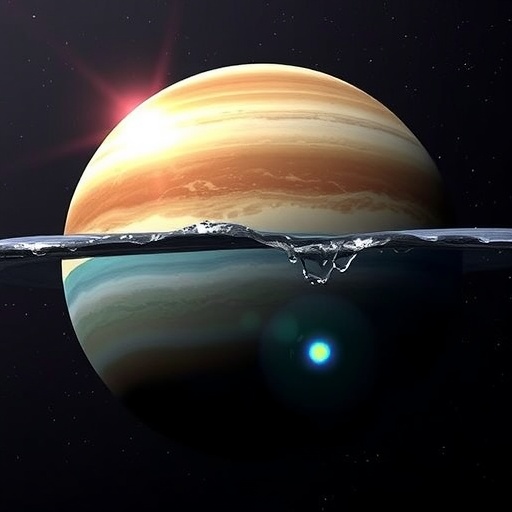Recent groundbreaking laboratory experiments have revealed a natural mechanism for the formation of water during the early stages of planet formation, presenting transformative implications for our understanding of planetary habitability. This pioneering research, conducted by an international team led by Francesca Miozzi and Anat Shahar, both affiliated with Carnegie Institution for Science, using cutting-edge high-pressure and high-temperature experimental techniques, has successfully simulated the extreme conditions of young terrestrial planets enveloped in dense hydrogen atmospheres with molten magma oceans. Their work establishes a direct experimental link between atmospheric hydrogen interactions and the genesis of water within the planet’s primordial magma, overturning longstanding assumptions that water must be delivered externally to rocky planets.
Sub-Neptune-sized planets, the most prevalent class of exoplanets discovered to date, exhibit mass and size characteristics that position them intriguingly between Earth and Neptune, typically hosting thick hydrogen-rich atmospheres with rocky interiors. These planets serve as natural laboratories to investigate early planetary processes, including the origin of internal water reservoirs, which are fundamental to understanding how life-essential environments could arise across the cosmos. Until now, the production of water during planet formation remained largely modeled through computational means, without experimental verification under representative conditions.
The researchers employed diamond anvil cells to replicate pressures approaching 60 gigapascals and temperatures exceeding 4,000 degrees Celsius—parameters that realistically mimic the conditions within a magma ocean overlain by a dense H₂ atmosphere during the nascent stages of planet building. By squeezing and heating iron-bearing silicate melts in the presence of molecular hydrogen, the team observed a remarkable chemical transformation: hydrogen molecules actively interacted with iron oxides in the melt, inducing reduction reactions that liberate water molecules within the molten silicates. Concurrently, significant quantities of hydrogen dissolved into the magma, potentially altering the planet’s compositional and physical traits.
This experimental demonstration bands together planetary geophysics, mineral physics, and atmospheric chemistry, revealing that early planetary interiors are not merely passive reservoirs but dynamic actors in water generation. The dissolution of hydrogen in the magma could influence melting behavior, core formation dynamics, and long-term volatile cycling between the atmosphere and interior. Moreover, the accumulation of water dissolved in the magma ocean could provide a substantial and stable supply of this vital liquid, persisting long before the planet’s magma solidifies and the atmosphere evolves operationally.
From an astronomical perspective, this mechanism elegantly solves the quandary of how rocky planets like Earth could harbor abundant water without relying entirely on late-stage delivery from comets or asteroids. Instead, water emerges as a natural product of formative chemical processes during the molten planet phase, mediated by the ubiquitous presence of hydrogen-dominated primordial atmospheres. Such atmospheres commonly blanket young planets due to residual gas in protoplanetary disks, sustaining high temperatures that maintain global magma oceans over geological durations.
The AEThER collaborative framework, spearheaded by Shahar and funded by the Alfred P. Sloan Foundation, furnished the interdisciplinary environment necessary for such a complex undertaking. This consortium melded expertise from astronomy, cosmochemistry, petrology, and planetary dynamics, generating a unified approach to deciphering the early evolution of exoplanetary systems. By integrating experimental data with theoretical models and observational constraints, AEThER advances predictions about planetary interiors’ chemical composition and the viability of habitable conditions in diverse planetary environments.
The implications of this study extend beyond the laboratory, reaching into the realm of observational astronomy and the search for life beyond Earth. If large quantities of water can form intrinsically during planet formation, planets within the habitable zones of distant stars may be more likely to host liquid water on or beneath their surfaces than previously believed. This enhances the prospects of identifying potentially habitable exoplanets simply by characterizing their bulk properties and atmospheric compositions rather than relying solely on indirect evidence of water delivery through impacts.
Furthermore, these findings challenge traditional interpretations of exoplanet atmospheres by illustrating that water signatures detected might not exclusively indicate surface oceans or cometary delivery but could derive from a rich interplay between interior processes and atmospheric chemistry during early evolution. This paradigm shift alters the way scientists prioritize targets for next-generation telescopes and space missions aimed at detecting biosignatures and assessing planetary habitability.
From a geochemical standpoint, understanding how hydrogen is incorporated and stored within silicate melts under extreme conditions informs models of core differentiation and mantle evolution. Hydrogen’s solubility in magma and concurrent water formation can affect melting points, viscosity, and electrical conductivity, consequently influencing magnetic field generation and tectonic activity—key factors that modulate a planet’s capacity to sustain life over billions of years.
The new experimental evidence is part of a broader scientific endeavor to unravel the complex narrative of planet formation, atmospheric evolution, and volatile cycling. By establishing hydrogen-rich atmospheres as not merely protective blankets but active chemical agents in creating water, this research bridges gaps between astrophysics, planetary science, and geochemistry. It heralds a new chapter in astrobiology, illuminating natural paths through which life-enabling conditions might arise across diverse planetary systems.
In conclusion, the discovery that significant quantities of water can be synthesized naturally and efficiently during planetary formation via interactions between hydrogen atmospheres and magma oceans reshapes fundamental concepts of planetary habitability. It invites scientists to rethink how water is measured, detected, and interpreted in relation to planetary history and to deepen interdisciplinary collaborations aimed at exploring the origins and distribution of life-giving volatiles throughout the Milky Way. This breakthrough provides a powerful lens to view newly discovered planets not just as passive recipients of water but as chemically dynamic worlds capable of self-generating the essential ingredient for life.
Subject of Research: Experimental study on planetary formation and water genesis under extreme conditions
Article Title: Experiments reveal extreme water generation during planet formation
News Publication Date: 30-Oct-2025
Web References: DOI: 10.1038/s41586-025-09816-z
Image Credits: Image courtesy of Navid Marvi/Carnegie Science.
Keywords: Planet formation, water generation, magma ocean, hydrogen atmosphere, Sub-Neptune, exoplanets, planetary habitability, high-pressure experiments, diamond anvil cell, volatile cycling, astrobiology, early planetary evolution




